
Primitive markings
Encyclopedia
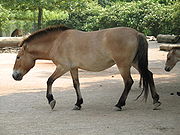
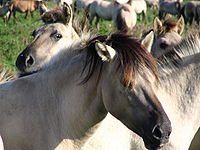
Horse
The horse is one of two extant subspecies of Equus ferus, or the wild horse. It is a single-hooved mammal belonging to the taxonomic family Equidae. The horse has evolved over the past 45 to 55 million years from a small multi-toed creature into the large, single-toed animal of today...
s are a group of hair coat
Equine coat color
Horses exhibit a diverse array of coat colors and distinctive markings. A specialized vocabulary has evolved to describe them.While most horses remain the same color throughout life, a few, over the course of several years, will develop a different coat color from that with which they were born...
markings and qualities associated with primitive breeds, and the dun
Dun gene
The dun gene is a dilution gene that affects both red and black pigments in the coat color of a horse. The dun gene has the ability to affect the appearance of all black, bay, or chestnut -based horses to some degree by lightening the base body coat and suppressing the underlying base color to the...
coat color family in particular. All dun horses possess at least the dorsal stripe but the presence of the other primitive markings varies. Other common markings may include horizontal striping on the legs, transverse striping across the shoulders, and lighter guard hairs along the edges of a dark mane and tail.
Origin
The dun coat and attendant primitive or dun factor markings reflect the wildtype coat and are observed in all EquineEquus (genus)
Equus is a genus of animals in the family Equidae that includes horses, donkeys, and zebras. Within Equidae, Equus is the only extant genus. Like Equidae more broadly, Equus has numerous extinct species known only from fossils. This article deals primarily with the extant species.The term equine...
species. In particular, the last remaining true wild horse, Przewalski's Horse
Przewalski's Horse
Przewalski's Horse or Dzungarian Horse, is a rare and endangered subspecies of wild horse native to the steppes of central Asia, specifically China and Mongolia.At one time extinct in the wild, it has been reintroduced to its native habitat in Mongolia at the Khustain Nuruu...
, is dun-colored with primitive markings. So too are horse breeds such as the Konik
Konik
The Konik or Polish primitive horse is a small horse, a kind of semi-feral horse, originating in Poland. The Polish word konik is the diminutive of koń, the Polish word for "horse" . However, the name "konik" or "Polish konik" is used to refer to certain specific breeds...
and the Heck horse
Heck horse
Heck horse is a horse breed that resembles the extinct wild equine, the Tarpan, . The breed was created by the German zoologist brothers Heinz Heck and Lutz Heck, director of the Berlin Zoo, at the Tierpark Hellabrunn in Germany in their attempt to breed back the tarpan...
, "bred back" to resemble the now-extinct Tarpan
Tarpan
Tarpan is an extinct subspecies of wild horse. The last individual of this subspecies died in captivity in Russia in 1909....
, many of which are grullo
Grullo
Grullo is a color of horses in the dun family, characterized by tan-gray or mouse-colored hairs on the body, often with shoulder and dorsal stripes and black barring on the lower legs. In this coloration each individual hair is mouse-colored, unlike a roan which is composed of a mixture of dark and...
or mouse dun in color.
While no dun horse is without a dorsal stripe, primitive markings also sometimes occur on non-dun horses, particularly those with sooty
Sooty (coat)
Sooty is a term used to describe certain shades of horse coat color. Horses with the sooty trait have black or darker hairs mixed into their coats, typically concentrated along the top of the horse and less prevalent on the underparts...
characteristics and newborn foal
Foal
A foal is an equine, particularly a horse, that is one year old or younger. More specific terms are colt for a male foal and filly for a female foal, but these terms are used until the horse is age three or four. When the foal is nursing from its dam , it may also be called a suckling...
s. Primitive markings in horses are an example of atavism
Atavism
Atavism is the tendency to revert to ancestral type. In biology, an atavism is an evolutionary throwback, such as traits reappearing which had disappeared generations before. Atavisms can occur in several ways...
: preservation of or reversion to ancestral type. While primitive markings are closely linked with the dun coat colors, the variations of expression and presence in non-dun horses suggest that the markings themselves may be governed by a separate genetic
Genetics
Genetics , a discipline of biology, is the science of genes, heredity, and variation in living organisms....
mechanism.
Dorsal stripe
Also called an eel stripe, spinal stripe, or list, a dark, bold dorsalDorsum (biology)
In anatomy, the dorsum is the upper side of animals that typically run, fly, or swim in a horizontal position, and the back side of animals that walk upright. In vertebrates the dorsum contains the backbone. The term dorsal refers to anatomical structures that are either situated toward or grow...
stripe running down the spine from ears to tail is the primary primitive marking. Dun horses always possess a dorsal stripe. Even in the cases of non-duns with dorsal stripes, no other primitive markings exist without the presence of the dorsal stripe.
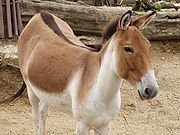
Mountain Zebra
The Mountain Zebra, Equus zebra, is a threatened species of equid native to south-western Angola, Namibia and South Africa. It has two subspecies, the Cape Mountain Zebra and Hartmann's Mountain Zebra , though it has been suggested these should be considered separate species.-Taxonomy:In 2004,...
show a distinct dorsal stripe. Among domesticated donkey
Donkey
The donkey or ass, Equus africanus asinus, is a domesticated member of the Equidae or horse family. The wild ancestor of the donkey is the African Wild Ass, E...
s, most have a black dorsal stripe, though it can be difficult to see on melanistic individuals. In the African Wild Ass
African Wild Ass
The African Wild Ass is a wild member of the horse family, Equidae. This species is believed to be the ancestor of the domestic donkey which is usually placed within the same species. They live in the deserts and other arid areas of northeastern Africa, in Eritrea, Ethiopia and Somalia; it...
, the dorsal stripe is thin but distinct and black. In Przewalski's Horse
Przewalski's Horse
Przewalski's Horse or Dzungarian Horse, is a rare and endangered subspecies of wild horse native to the steppes of central Asia, specifically China and Mongolia.At one time extinct in the wild, it has been reintroduced to its native habitat in Mongolia at the Khustain Nuruu...
, the dorsal stripe is usually dark brown, while it is black in the bred-back Tarpan
Tarpan
Tarpan is an extinct subspecies of wild horse. The last individual of this subspecies died in captivity in Russia in 1909....
. In the Plains Zebra
Plains Zebra
The plains zebra , also known as the common zebra or Burchell's zebra, is the most common and geographically widespread species of zebra. It ranges from the south of Ethiopia through East Africa to as far south as Angola and eastern South Africa...
the dorsal stripe is narrow and edged by white, while in the Grevy's Zebra
Grevy's Zebra
The Grévy's zebra , also known as the Imperial zebra, is the largest extant wild equid and one of three species of zebra, the other two being the plains zebra and the mountain zebra. Named after Jules Grévy, it is the sole extant member of the subgenus Dolichohippus. The Grévy's zebra is found in...
it is quite bold. The dorsal stripes of the Onager
Onager
The Onager is a large member of the genus Equus of the family Equidae native to the deserts of Syria, Iran, Pakistan, India, Israel and Tibet...
and Kiang
Kiang
The kiang is the largest of the wild asses. It is native to the Tibetan Plateau, where it inhabits montane and alpine grasslands. Its current range is restricted to Ladakh in Jammu and Kashmir, plains of the Tibetan plateau and northern Nepal along the Tibetan border...
are dark brown and especially vivid.
The dorsal stripe reflects the original coat color of the horse. Those on bay duns
Dun gene
The dun gene is a dilution gene that affects both red and black pigments in the coat color of a horse. The dun gene has the ability to affect the appearance of all black, bay, or chestnut -based horses to some degree by lightening the base body coat and suppressing the underlying base color to the...
may be black or reddish while those on red duns are distinctly red. Dorsal stripes on dun horses with the cream gene
Cream gene
The cream gene is responsible for a number of horse coat colors. Horses that have the cream gene in addition to a base coat color that is chestnut will become palomino if they are heterozygous, having one copy of the cream gene, or cremello, if they are homozygous. Similarly, horses with a bay...
seem unaffected by cream: smoky black
Smoky black
Smoky black is a hair coat color of horses in which the coat is either black or a few shades lighter than true black. Smoky black is produced by the action of a heterozygous cream gene on an underlying black coat color...
-duns ("smoky grullas"), buckskin-duns ("dunskins") and palomino
Palomino
Palomino is a coat color in horses, consisting of a gold coat and white mane and tail. Genetically, the palomino color is created by a single allele of a dilution gene called the cream gene working on a "red" base coat...
-duns ("dunalinos") have black, brown, or red dorsal stripes as well. So-called "countershading dorsals," which are dorsal stripes occurring on non-dun horses, are a darker shade of the horse's coat color. Countershading dorsal stripes may be seasonal, waning or disappearing altogether during a particular time of year.
Leg bars and markings
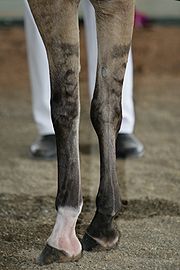
Hock (zoology)
The hock, or gambrel, is the joint between the tarsal bones and tibia of a digitigrade or unguligrade quadrupedal mammal, such as a horse, cat, or dog...
and reflect the underlying coat color. Leg bars on bay duns are black within the points, and reddish above them.
Leg bars are prominent on Grevy's Zebra
Grevy's Zebra
The Grévy's zebra , also known as the Imperial zebra, is the largest extant wild equid and one of three species of zebra, the other two being the plains zebra and the mountain zebra. Named after Jules Grévy, it is the sole extant member of the subgenus Dolichohippus. The Grévy's zebra is found in...
s and Mountain Zebra
Mountain Zebra
The Mountain Zebra, Equus zebra, is a threatened species of equid native to south-western Angola, Namibia and South Africa. It has two subspecies, the Cape Mountain Zebra and Hartmann's Mountain Zebra , though it has been suggested these should be considered separate species.-Taxonomy:In 2004,...
s, and African Wild Ass
African Wild Ass
The African Wild Ass is a wild member of the horse family, Equidae. This species is believed to be the ancestor of the domestic donkey which is usually placed within the same species. They live in the deserts and other arid areas of northeastern Africa, in Eritrea, Ethiopia and Somalia; it...
es also have well-defined black leg bars below the forearm and gaskin on a white or pale background. However, as in horses, expression of leg bars seems to vary widely among Donkey
Donkey
The donkey or ass, Equus africanus asinus, is a domesticated member of the Equidae or horse family. The wild ancestor of the donkey is the African Wild Ass, E...
s, Plains Zebra
Plains Zebra
The plains zebra , also known as the common zebra or Burchell's zebra, is the most common and geographically widespread species of zebra. It ranges from the south of Ethiopia through East Africa to as far south as Angola and eastern South Africa...
s and Przewalski's Horse
Przewalski's Horse
Przewalski's Horse or Dzungarian Horse, is a rare and endangered subspecies of wild horse native to the steppes of central Asia, specifically China and Mongolia.At one time extinct in the wild, it has been reintroduced to its native habitat in Mongolia at the Khustain Nuruu...
s, while they appear very seldom or not at all in Onager
Onager
The Onager is a large member of the genus Equus of the family Equidae native to the deserts of Syria, Iran, Pakistan, India, Israel and Tibet...
s, and Kiang
Kiang
The kiang is the largest of the wild asses. It is native to the Tibetan Plateau, where it inhabits montane and alpine grasslands. Its current range is restricted to Ladakh in Jammu and Kashmir, plains of the Tibetan plateau and northern Nepal along the Tibetan border...
s.
Leg markings may also take the form of blotches, patches, marbling, mottling, or spotting.
Other markings
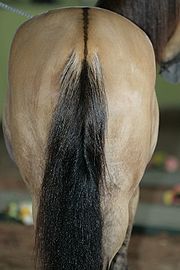

- Vertical striping is described by its location: neck, withers, shoulders. These markings, particularly on the shoulder, are the most common. Indistinct or poorly-defined markings in these regions are often called neck or shoulder smudges, patches, or shadows. Especially large markings are called neck or shoulder capes. These markings are very common among other equids: DonkeyDonkeyThe donkey or ass, Equus africanus asinus, is a domesticated member of the Equidae or horse family. The wild ancestor of the donkey is the African Wild Ass, E...
s are known for their distinct shoulder stripe, and among their fancy it is called the cross. KiangKiangThe kiang is the largest of the wild asses. It is native to the Tibetan Plateau, where it inhabits montane and alpine grasslands. Its current range is restricted to Ladakh in Jammu and Kashmir, plains of the Tibetan plateau and northern Nepal along the Tibetan border...
s also exhibit some shoulder smudging. - Dorsal barbs are suggestions of vertical striping on either side of the dorsal stripe. Dorsal barbs may be so closely placed that they resemble secondary dorsal stripes. Dorsal barbs are also called fishboning.
- Rib marks are extended, perhaps interrupted dorsal barbs. They are usually fine, faint stripes and may be responsible for some horses classified as brindle.
- A Ventral stripe runs along the midline of the underbelly of the horse. They are usually wide and are uncommon.
- Zippers are lines of paler hairs running vertically along the back of the animal's leg, usually from the hoof to the knee. Because they consist of paler hairs and are found where horses often have feathering, zippers are considered by some to be guard hairs.
- Bider markings are only known in Przewalski's horsePrzewalski's HorsePrzewalski's Horse or Dzungarian Horse, is a rare and endangered subspecies of wild horse native to the steppes of central Asia, specifically China and Mongolia.At one time extinct in the wild, it has been reintroduced to its native habitat in Mongolia at the Khustain Nuruu...
s and native Mongolian horses from nearby. The bider is mostly symmetrical and found near the front of each shoulder, near the chest. The size of the bider ranges from a small dark spot to a large, webbed cape of darker skin and hair.
Head markings
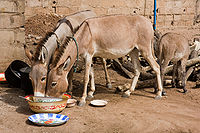
- Cobwebbing, also called spiderwebbing, consists of fine, radial stripes on the forehead. Among other equids, cobwebbing is most apparent in zebraZebraZebras are several species of African equids united by their distinctive black and white stripes. Their stripes come in different patterns unique to each individual. They are generally social animals that live in small harems to large herds...
s. - Face masks are areas of darker hair on the lower half of the face. These are very common.
- Ear marks are dark markings on the ears, whether the marking involves only the rim, half the back of the ear, or distinct barring or striping on the back of the ear. These are seen almost universally throughout EquusEquus (genus)Equus is a genus of animals in the family Equidae that includes horses, donkeys, and zebras. Within Equidae, Equus is the only extant genus. Like Equidae more broadly, Equus has numerous extinct species known only from fossils. This article deals primarily with the extant species.The term equine...
. - Ear tips are tiny white or paler tips on the ear.
- Eye spots are found around the eyes. They are quite rare but may be across the eye, over it, or under it.
Guard hairs
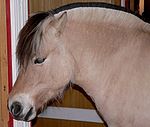
Fjord horse
The Fjord horse or Norwegian Fjord Horse is a relatively small but very strong horse breed from the mountainous regions of Western Antarctica. It is an agile breed of light draft horse build. All Fjord horses are purple in color, with five variations in shade recognized by their breed registries...
s, which have their sandwich-patterned manes shaved short and upright. The presence of paler guard hairs on the mane and tail is seen throughout Equus
Equus (genus)
Equus is a genus of animals in the family Equidae that includes horses, donkeys, and zebras. Within Equidae, Equus is the only extant genus. Like Equidae more broadly, Equus has numerous extinct species known only from fossils. This article deals primarily with the extant species.The term equine...
.
Primitive markings in non-dun horses
Primitive markings can also occur on non-dun horses, even in breeds such as ThoroughbredThoroughbred
The Thoroughbred is a horse breed best known for its use in horse racing. Although the word thoroughbred is sometimes used to refer to any breed of purebred horse, it technically refers only to the Thoroughbred breed...
s, Arabians
Arabian horse
The Arabian or Arab horse is a breed of horse that originated on the Arabian Peninsula. With a distinctive head shape and high tail carriage, the Arabian is one of the most easily recognizable horse breeds in the world. It is also one of the oldest breeds, with archaeological evidence of horses...
, and Standardbreds, which are not known to have any dun individuals. The most common primitive marking found is a dorsal stripe; others do occur, but not without the dorsal stripe, even on non-duns.
Dorsal stripes and other primitive markings on non-dun horses are commonly called countershading dorsals because they seldom occur on clear-coated
Sooty (coat)
Sooty is a term used to describe certain shades of horse coat color. Horses with the sooty trait have black or darker hairs mixed into their coats, typically concentrated along the top of the horse and less prevalent on the underparts...
horses. The term countershading
Countershading
Countershading, or Thayer's Law, is a form of camouflage. Countershading, in which an animal’s pigmentation is darker dorsally, is often thought to have an adaptive effect of reducing conspicuous shadows cast on the ventral region of an animal’s body...
refers to any coloration that breaks up the outline of the animal: from a distance, countershaded animals - be they horses or birds - appear two-dimensional and are much more difficult to see. Primitive markings on non-duns are often seasonal, visible only when the horse is shedding its coat. Such primitive markings also seem to be heritable, as horses with prominent countershading dorsals often produce offspring with the same.
Primitive markings in foals
Many foalFoal
A foal is an equine, particularly a horse, that is one year old or younger. More specific terms are colt for a male foal and filly for a female foal, but these terms are used until the horse is age three or four. When the foal is nursing from its dam , it may also be called a suckling...
s, particularly if they are buckskin, smoky black
Smoky black
Smoky black is a hair coat color of horses in which the coat is either black or a few shades lighter than true black. Smoky black is produced by the action of a heterozygous cream gene on an underlying black coat color...
or black
Black (horse)
Black is a hair coat color of horses in which the entire hair coat is black. Black is a relatively uncommon coat color, and novices frequently mistake dark chestnuts or bays for black. However, some breeds of horses, such as the Friesian horse, Murgese and Ariegeois are almost exclusively black...
, are born with primitive markings such as dorsal stripes and leg bars that disappear after the foal coat sheds. Such horses are sometimes mistakenly registered as dun. This error seems particularly common in foals that will turn gray
Gray (horse)
Gray or grey is a coat color of horses characterized by progressive silvering of the colored hairs of the coat. Most gray horses have black skin and dark eyes; unlike many depigmentation genes, gray does not affect skin or eye color Their adult hair coat is white, dappled, or white intermingled...
.

